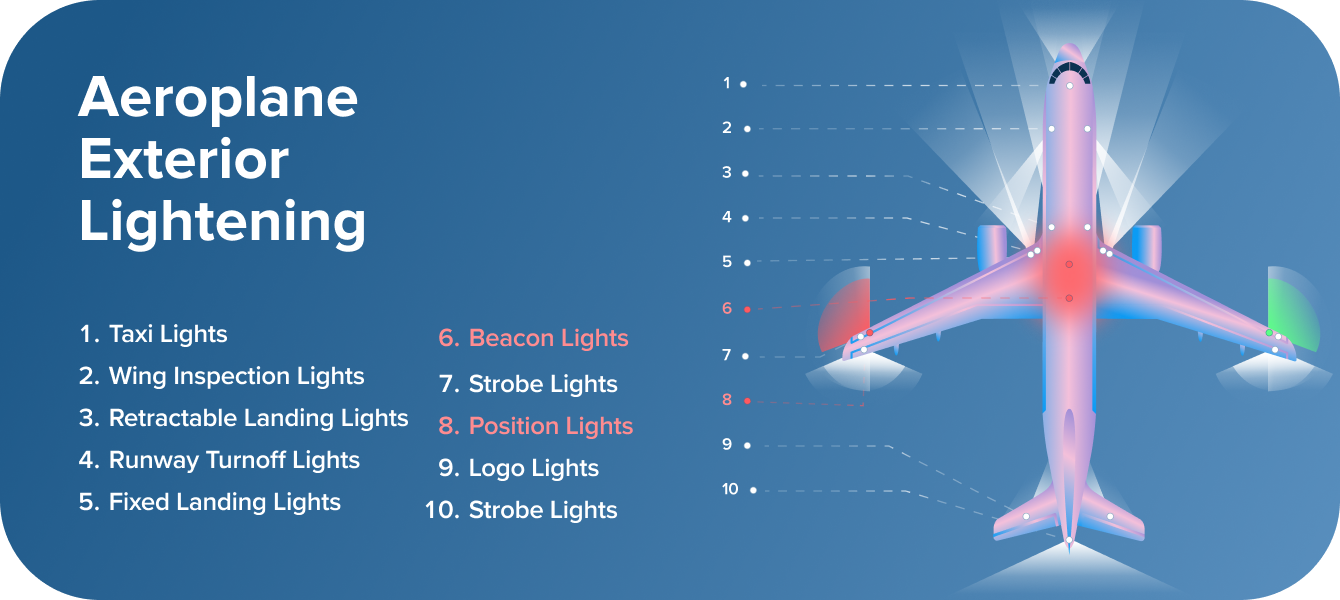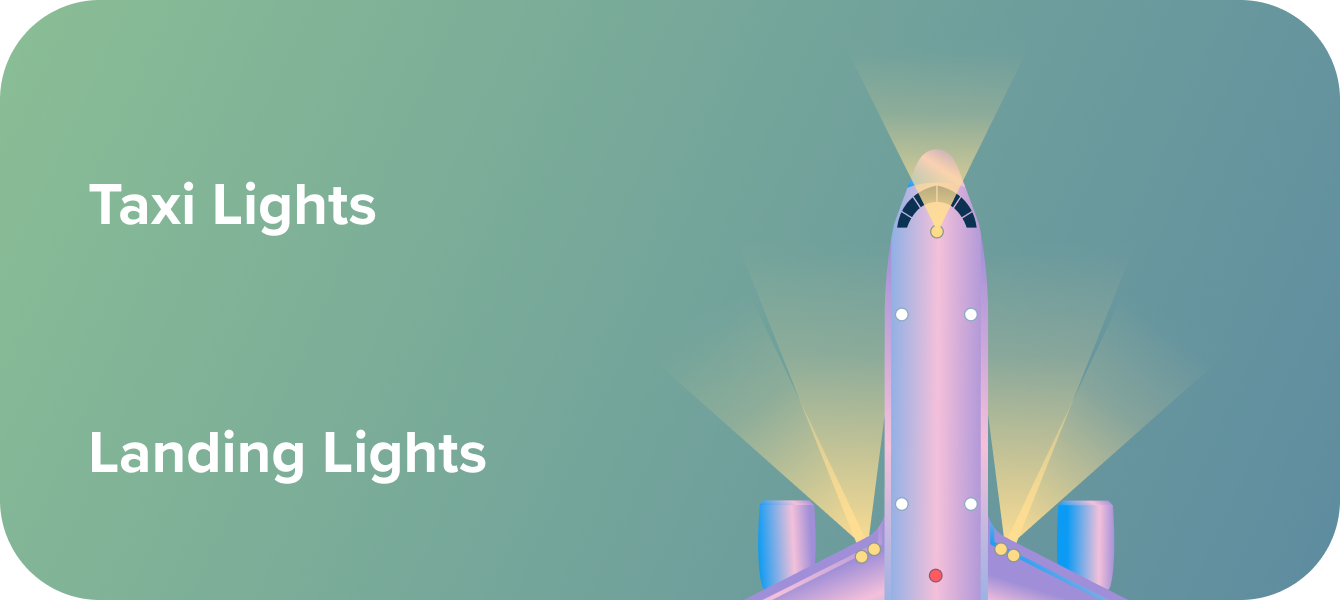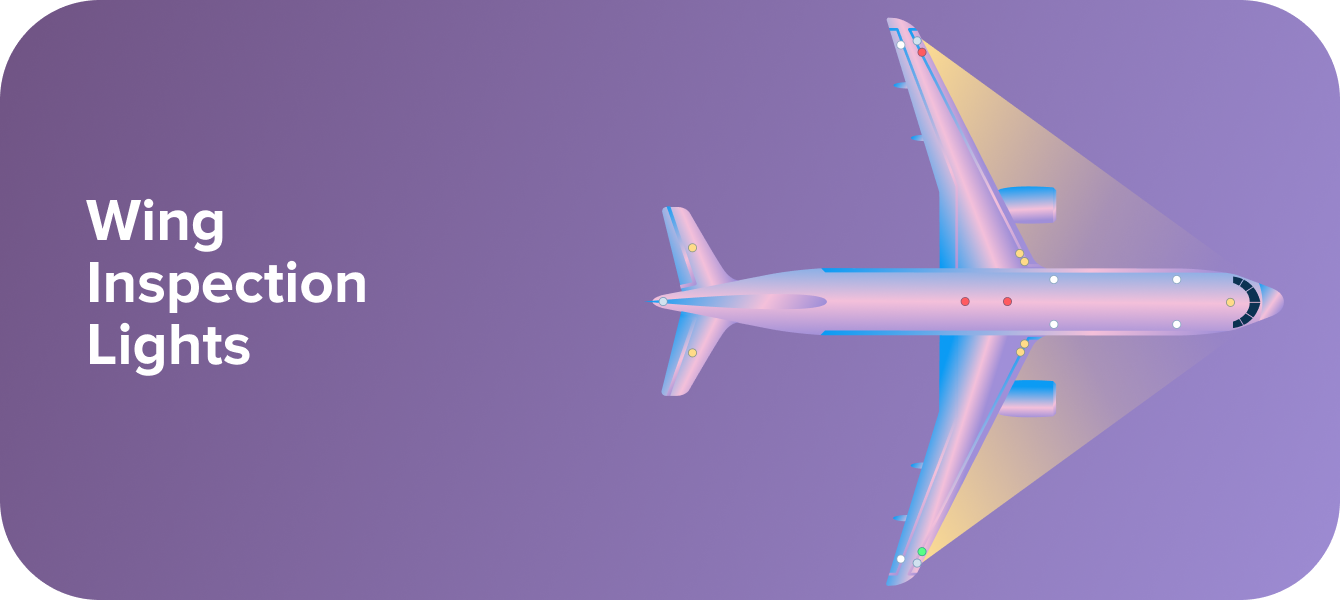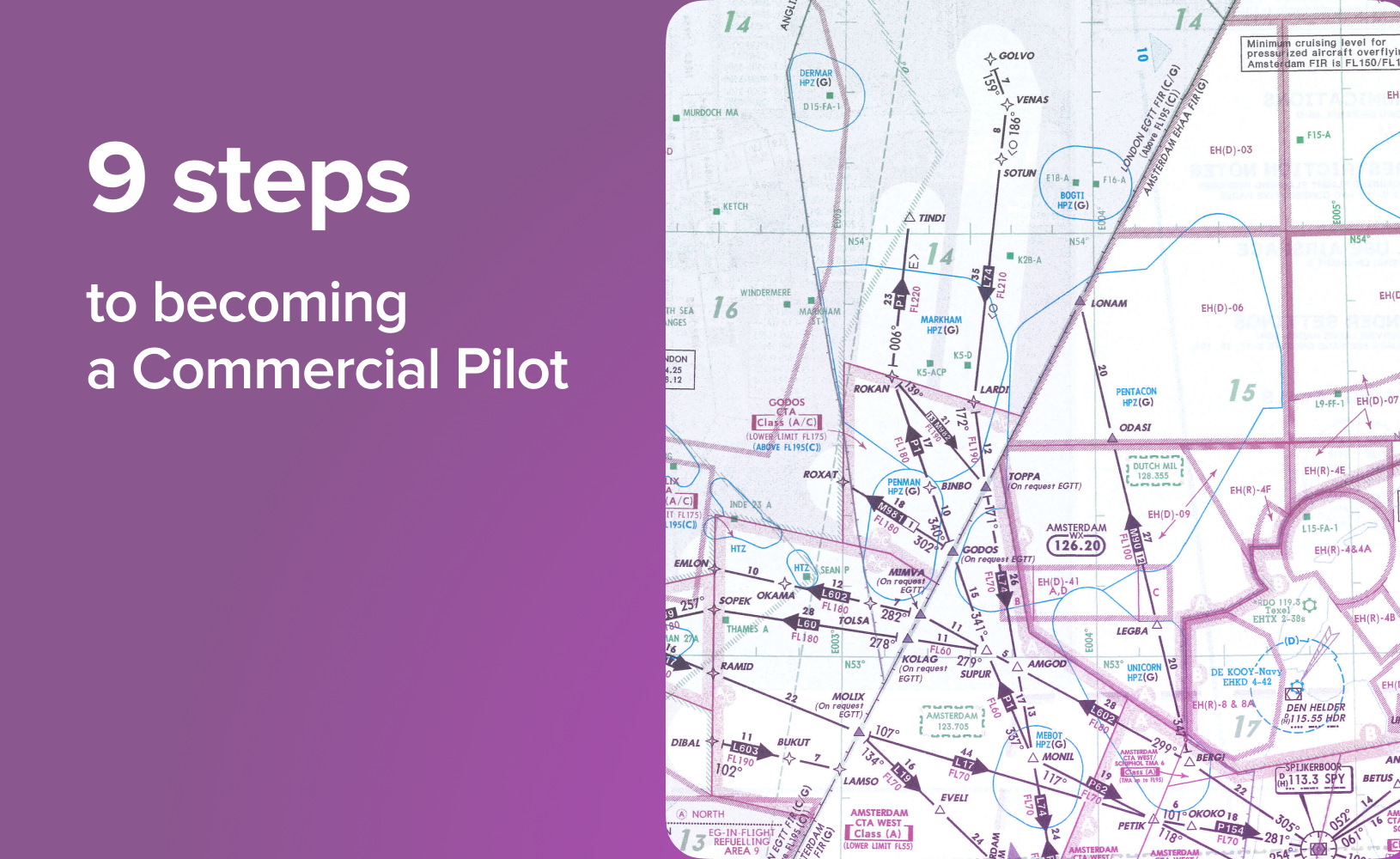Aeroplane Lights: Red, Green, White, and More

Have you ever looked up at the night sky and spotted flashing lights moving across the horizon? Is it a drone, a satellite, or an aeroplane? And what do those lights mean?
As a budding pilot or aviation enthusiast, you’ve probably noticed the steady and flashing lights on aircraft and wondered about their purpose. These lights serve essential navigation, safety, and communication functions.
While lighting configurations vary between aircraft, a standard framework applies to aviation. The type of lights an aircraft has depends on its design, operational requirements, and even the time of day. In this article, we’ll break down the different lights you’ll encounter on an aeroplane and what each one does.
Build a solid foundation for your Aircraft General Knowledge studies with our blog From Nose to Tail: Aircraft Parts and Their Functions. We break down aircraft components.
The Importance of Aeroplane Lighting

Aeroplane lights are crucial for aviation safety. They enhance visibility in low-light conditions, allowing pilots to see and be seen by other aircraft and ground personnel. These lights also play a vital role in communication, signalling the aircraft's position and direction to other pilots and air traffic controllers.
Aircraft lights can be divided into three main categories based on their function:
Visibility for Other Aircraft: Certain lights ensure the aeroplane is clearly visible to other pilots, air traffic controllers, and ground crews, reducing the risk of collisions.
Illumination for Pilots: Some lights help pilots see essential areas of the aircraft or runway, particularly during take-off, landing, and taxiing.
Operational Illumination: Other lights serve specific functions, such as inspecting the wings, assisting with in-flight refuelling, or providing signals to ground personnel.
Interestingly, while some lights—such as navigation and anti-collision lights—are legally required, others are not. A broken light is unlikely to delay a flight, as most are easily replaceable and do not typically affect an aircraft’s airworthiness.
Now, let’s have a closer look at the most common aircraft lights used for each of these purposes.
Understand the fundamental forces of lift, drag, thrust, and gravity that govern the magic of flight in our blog: Mastering Flight: The 4 Forces Explained.
Lights That Make the Aircraft More Visible
Aeroplanes operate in constantly changing environments, often flying at night, through clouds, or in congested airspace. To ensure safety, aircraft are equipped with lights designed to make them more visible to other pilots, air traffic controllers, and ground crews. These lights do not illuminate the aircraft’s path but instead serve as crucial signals that help prevent collisions and improve situational awareness.
The following three primary groups of lights are used to enhance visibility.
Navigation Lights

One of the most important visibility lights on an aircraft is the navigation lights, also known as position lights. They help other pilots and air traffic controllers determine an aircraft’s position and direction.
These lights follow the same convention as maritime vessels, which first implemented this system to reduce collisions at sea. Aircraft adopted the same principles. These are steady, non-flashing lights located on the wingtips and tail:
Red light on the left (port) wingtip
Green light on the right (starboard) wingtip
White light on the tail (sometimes also on wingtips, facing aft)
Navigation lights allow other pilots to quickly assess an aircraft’s orientation. For example:
If you see both red and green lights, the aircraft is flying towards you.
If you only see a red light, the aircraft is passing from right to left. If you only see a green light, the aircraft is passing from left to right. If you see only a white light, the aircraft is flying away from you.
Though navigation lights are only required at night, many pilots keep them switched on to improve visibility in all conditions.
While the terms navigation lights and position lights are frequently used interchangeably, some sources distinguish them based on function. Position lights specifically help other pilots determine an aircraft’s orientation and direction of travel, while navigation lights refer more broadly to lights that assist with aircraft recognition and identification. However, in most operational contexts, these lights serve the same purpose—ensuring that an aircraft is visible and its direction can be identified.
Experience the magic of night flying. Conquer the unique challenges and unlock the rewards of flying under the stars. Read our blog: Night Flying: A Guide for New Pilot Training.
Beacon (Red Anti-Collision) Lights

Beacon lights, also called red anti-collision lights, indicate when an aircraft is in operation. They are flashing red lights located on the top of the fuselage and, on larger aircraft, also on the bottom of the fuselage.
These lights are activated before the engine starts and remain on until the engines are completely shut down. This acts as a warning to ground crews that the aircraft is about to move or has its engines running.
Beacon lights serve several critical functions. Firstly, they alert ground personnel to the presence of moving aircraft, minimising the risk of ground collisions. Secondly, they signal that an aircraft is preparing for flight, alerting those in the vicinity. Finally, beacon lights provide a visual cue to other pilots during taxiing and ground operations, enhancing situational awareness on the airfield.
Strobe Lights

Strobe lights, also known as white anti-collision lights, are high-intensity flashing lights located on the wingtips. Their purpose is to make the aircraft visible from long distances, especially during flight.
These bright white lights flash intermittently and are used only when the aircraft is on an active runway or in flight. They are too bright for use during taxiing or when parked, as they could dazzle ground crew and other pilots.
Strobe lights are used across various flight phases.
During take-off and landing: They are crucial for the greatest visibility in busy airspace, ensuring safe separation from other aircraft.
In flight: Strobe lights are essential for ensuring the aircraft is easily spotted from miles away, significantly improving safety.
In low-visibility conditions: These lights are particularly critical when flying through clouds or close to other aircraft, providing a crucial visual cue.
While some lights, such as navigation lights, are required by law, others—like strobe lights—are standard practice to enhance safety.
Without these lights, flying in busy airspace, at night, or in poor weather conditions would be far more hazardous. Every flashing light in the sky plays a role in keeping aviation as safe and efficient as possible.
Lights That Help Pilots See Essential Areas
Certain aircraft lights are designed specifically to illuminate critical areas, ensuring pilots have clear visibility during take-off, landing, and taxiing. These lights are crucial for safe ground operations, night flights, and low-visibility conditions. While they primarily serve the flight crew, many of them also improve overall aircraft visibility, reducing the risk of collisions.
Landing Lights

Landing lights are among the brightest lights on an aircraft, mounted on the wings, nose landing gear, or fuselage. These powerful lights serve two essential functions:
Illuminating the Runway – They help pilots see the runway surface during take-off and landing, ensuring a clear view of markings, obstacles, and potential hazards.
Increasing Aircraft Visibility – Even in daylight, landing lights make aircraft more noticeable to other pilots and air traffic controllers, reducing the risk of mid-air collisions—especially in busy airspace.
Landing lights play a crucial role in enhancing safety during various flight phases.
During take-off and landing: They are essential for illuminating the approach and departure paths, enabling pilots to clearly identify the runway and surrounding terrain.
Below 10,000 feet: Pilots often activate landing lights in congested airspace to improve their visibility to other aircraft, enhancing situational awareness.
In low-visibility conditions: Landing lights are indispensable in challenging weather conditions such as fog, heavy rain, or during night operations, providing vital illumination for safe manoeuvring.
Landing lights are so bright that they cannot be used when taxiing in airports at night, as they could blind ground crew or other pilots. Instead, dimmer taxi lights are used until take-off clearance is given.
Taxi Lights
Taxi lights are located on the nose landing gear or fuselage and are used on the ground to help pilots navigate taxiways, aprons, and parking areas. They are dimmer then landing lights and used only for ground operations at low speeds.
When Are Taxi Lights Used?
During ground movement – When taxiing to and from the runway.
After landing – To guide the aircraft safely to its designated gate or parking stand.
Runway Turnoff Lights

Runway turnoff lights are positioned on the nose landing gear or the lower fuselage and help illuminate the edges of the taxiway or runway exit.
These lights are particularly useful at large, complex airports where taxiways may have multiple exits and sharp turns. They provide extra light when making sharp turns off the runway and help pilots see taxiway intersections and signs more clearly at night.
Learn about the different types of runway lights, their colours, and their significance in our blog: Runway Lighting: Colours, Spacing, and Types.
Wing Inspection Lights

Wing inspection lights are installed on the fuselage, just ahead of the wings, and are directed toward the leading edges of the wings and engine inlets. They serve a critical role in monitoring the aircraft’s condition in flight.
Functions of Wing Inspection Lights:
Checking for ice formation: Ice build-up on the wings can disrupt airflow and reduce lift. These lights allow pilots to visually inspect the wings from the cockpit.
Engine and surface checks: Crew members can monitor the condition of the engine inlets and leading edges.
Commercial airliners operating in cold weather climates, where ice accumulation on the wings is a significant concern, frequently use these lights. Similarly, military aircraft flying at high altitudes, exposed to icy temperatures, also rely on wing inspection lights to mitigate the risk of ice formation.
While not all of these lights are legally required, they are widely used due to their safety benefits and practical advantages. A well-lit aircraft is easier to control, easier to see, and ultimately safer in all phases of flight.
Soar above the clouds or navigate through them? Explore the differences between Visual Flight Rules (VFR) and Instrument Flight Rules (IFR) in our blog: Beyond the Clouds: VFR vs. IFR.
Specialised Lights for Different Operations
Beyond navigation and visibility lights, aircraft are also equipped with specialised lighting systems designed for specific operational needs. These lights serve a range of functions, from improving visibility on the ground to assisting military pilots during formation flying.
The three main types of various purpose lighting are:
Logo Lights

Logo lights are mounted on the tail fin and illuminate an airline’s logo. While they serve a branding purpose, they also play a functional role in safety.
Why Are Logo Lights Important?
Increase aircraft visibility at night, especially at busy airports.
Help ground crew and air traffic controllers identify aircraft more easily.
Improve aesthetics – Many airlines use them to enhance brand recognition.
Although not legally required, most commercial airlines keep logo lights switched on during night operations for enhanced visibility.
Searchlights
High-intensity lights primarily used on helicopters and some fixed-wing aircraft. These powerful lights are essential for ground illumination during search-and-rescue operations, assisting in locating individuals or objects at night. They are also used by law enforcement agencies for various purposes, including tracking vehicles or individuals.
Formation Lights (Military)
Specialised lights found on military aircraft, crucial for maintaining precise formation during night operations. Positioned strategically along the fuselage and wings, these lights act as visual guides for pilots, ensuring correct positioning in close proximity to other aircraft. Many formation lights are designed with stealth in mind, emitting dim light or utilising infrared technology, allowing military aircraft to maintain formation without compromising their visibility to adversaries.
Unlike navigation or anti-collision lights, various purpose lighting is tailored for specific operational needs. Whether it’s a police helicopter searching for a suspect, an airliner improving night-time visibility, or a fighter jet flying in formation, these lights provide pilots with additional tools to enhance safety, efficiency, and mission success.
Airhead's Takeaway

Aircraft lighting is essential for safety, visibility, and operational efficiency, ensuring smooth and secure flights in all conditions.
Navigation (Position) Lights indicate an aircraft’s position and direction.
Beacon and Strobe Lights enhance visibility and help prevent collisions.
Landing, Taxi, and Runway Turnoff Lights improve a pilot’s visibility during take-off, landing, and ground manoeuvres.
Wing Inspection and Searchlights assist with safety checks, ice detection, and special operations.
Logo and Formation Lights serve both identification and operational purposes.
Next time you see an aeroplane’s lights flashing in the sky, you’ll know exactly what they mean!






























